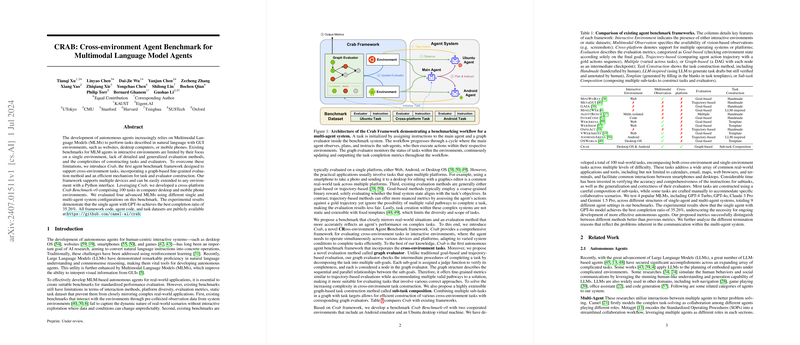Overview of CRAB: Cross-environment Agent Benchmark for Multimodal LLM Agents
The paper "CRAB: Cross-environment Agent Benchmark for Multimodal LLM Agents" introduces a sophisticated framework for evaluating autonomous agents, known as CRAB. This benchmark is designed to overcome the limitations of existing benchmarks by supporting cross-environment tasks and adopting an advanced graph-based evaluation method.
Core Contributions
The paper presents several key contributions to the field of autonomous agents and multimodal LLMs (MLMs):
- Cross-environment Tasks: CRAB is the first framework to facilitate agent benchmarking across multiple environments, allowing agents to interact with desktop computers and mobile devices through a standardized interface. This approach mirrors complex real-world applications more closely than traditional single-environment tasks.
- Graph Evaluator: A novel graph-based evaluation method is employed, decomposing tasks into multiple sub-goals represented as nodes within a Directed Acyclic Graph (DAG). This method offers fine-grained evaluation metrics, accommodating diverse valid pathways to task completion and addressing limitations of goal-based and trajectory-based metrics.
- Task and Evaluator Construction: The framework introduces a scalable task generation method using sub-task composition within a graph structure. This approach enables effective task construction and the creation of corresponding graph evaluators, enhancing the benchmark's flexibility and extensibility.
- Comprehensive Benchmarking: CRAB is implemented with a Python interface across virtual environments, featuring 120 tasks in computer desktop and mobile phone settings. It supports a variety of MLMs and different agent system configurations.
Experimental Evaluation
The paper evaluates multiple advanced MLMs, including GPT-4o and GPT-4 Turbo, using various agent configurations (single-agent, multi-agent by functionality, and multi-agent by environment). The evaluation highlights several findings:
- Performance Metrics: GPT-4o, configured as a single agent, achieved the highest completion ratio of 38.01%, demonstrating superior task completion capability. The paper introduces new metrics, such as Completion Ratio (CR) and Execution Efficiency (EE), which provide insightful measures of agent performance beyond traditional success rates.
- Agent Structures: Single-agent configurations generally outperformed multi-agent systems, likely due to communication challenges inherent in multi-agent setups. However, the added complexity of multi-environment tasks underscores the importance of designing robust communication protocols within agent systems.
- Implications for Future AI: The results suggest the need for ongoing advancements in autonomous agents capable of handling cross-platform interactions. Further development in improving communication efficacy and reducing information loss in multi-agent frameworks is recommended.
Practical and Theoretical Implications
CRAB's introduction sets a new standard for evaluating MLM-based autonomous agents by:
- Enhancing Real-world Applicability: By supporting cross-environment interactions, CRAB benchmarks more realistic tasks reflecting how humans use technology in everyday scenarios.
- Improving Evaluation Precision: The graph-based evaluator advances the precision of autonomous agent assessments, crucial for developing reliable systems.
- Guiding Future Research: The findings provide valuable insights for future research directions, emphasizing the need for sophisticated communication strategies in multi-agent systems.
Conclusion
The CRAB benchmark represents a significant advancement in autonomous agent research, providing a robust framework for evaluating MLM agents across complex, multi-platform environments. Its innovative graph-based evaluation method and expansive task set promise to enhance our understanding and development of these systems, paving the way for future innovations in AI technology.
